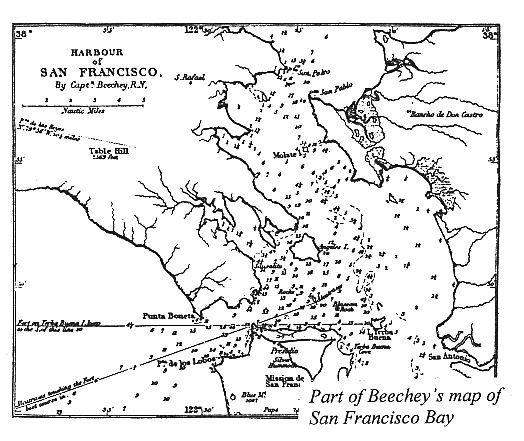| ||||
|
| ||||
|
FREDERICK
BEECHEY
 Lived:
1796-1857
Lived:
1796-1857
Explored California in: 1826-1828
Exploring for: England
Explored: by ship in San Francisco Bay
The important harbor of San Francisco Bay was missed by all the explorers who sailed along the California coast before 1775. Not until 1826, when Frederick William Beechey sailed through the Golden Gate, was a thorough charting done of the bay.
EARLY HISTORY
Frederick William Beechey was
born in
At the age of 10, young Frederick was sent to join the navy. His career at sea was long and full of adventure. Before he was 20, he had fought in several naval battles. He was on the Mississippi River during the War of 1812. He was part of Commander John Franklin’s polar expedition in 1817-18, and in 1819 was with Commander Perry in the Arctic. In 1821 Beechey explored the North African coast.
BACKGROUND
The situation in California had
changed in 1821, when
BEECHEY’S JOURNEY
The sloop H.M.S. Blossom,
under the command of Frederick Beechey, left Spithead,
Beechey’s route was across the Atlantic Ocean, around Cape Horn, and up the coast of South and North America to the Bering Strait. He hoped to meet Franklin’s party during the summer of 1826, and again in the summer of 1827. In between, he was to explore the coast of northern California.
When Beechey failed to find Franklin in the Arctic in 1826, he sailed south to California. On November 6, 1826, he entered San Francisco Bay through the Golden Gate. The Blossom explored and charted the bay from November 6 to December 28, 1826.
The same thing happened in 1827. Beechey and Franklin did not meet in the Arctic, and the Blossom spent the time from November 18 to December 5 in San Francisco Bay.
The Mexican officials seemed pleased to help Beechey and his men, asking only that a copy of the final maps and charts be given to them. Beechey was given permission to visit anywhere he liked, and to take whatever measurements were needed.
On board the Blossom was a 38-foot barge equipped for exploring around islands and coastlines. With this barge, Beechey took hundreds of soundings from the north to the south end of San Francisco Bay. He also explored the land around the bay, mapping trails and geographic al features.
Without meaning to do so, Beechey switched the names, given by Captain Juan Ayala in 1775, of two islands in the bay. On Beechey’s charts, the island that Ayala had named Yerba Buena became Alcatraz, and the larger island to the south became Yerba Buena. These are the names used today for these islands.
The information recorded by Beechey for ships entering the Golden Gate was detailed. He described the safest channels and how to work with the winds and tides. He warned about a large rock (190 ft by 100 ft) that was just below the water at low tide. Beechey named it Blossom Rock. In 1870, San Francisco engineers exploded the rock.
With Beechey was James Wolfe, a chartmaker and diary writer, who recorded information about the people and their way of life. There were also two artists on board, one of them Frederick’s younger brother, Richard. The fine watercolor illustrations made by Richard Beechey were an important outcome of the voyage.
Beechey’s report predicted that the San Francisco Bay area would “at some future time, be of great importance.” He also expressed surprise, as had visitors before him, that the great natural resources were so little developed by the Spanish. He described the San Francisco Presidio as being almost in ruins, with half of its walls broken down. The missions, though not impressive, were in somewhat better shape.
WHAT HE ACCOMPLISHED
Beechey’s Narrative of a Voyage to the Pacific and Beering’s [sic] Strait was published in London in 1831, and was immediately popular as a travel diary. It is of interest to historians today for the vivid description of life in Mexican California.
The charts and maps of San Francisco Bay were published by the British Admiralty in 1833, and formed the basis for all maps of the area for several decades.
LATER YEARS
After his second visit to San Francisco Bay, Beechey headed back to England. This was Beechey’s last voyage, though he lived for 30 more years. Despite failing health, he was active in the Royal Geographic Society of London, and was serving as president of the Society when he died in 1857.